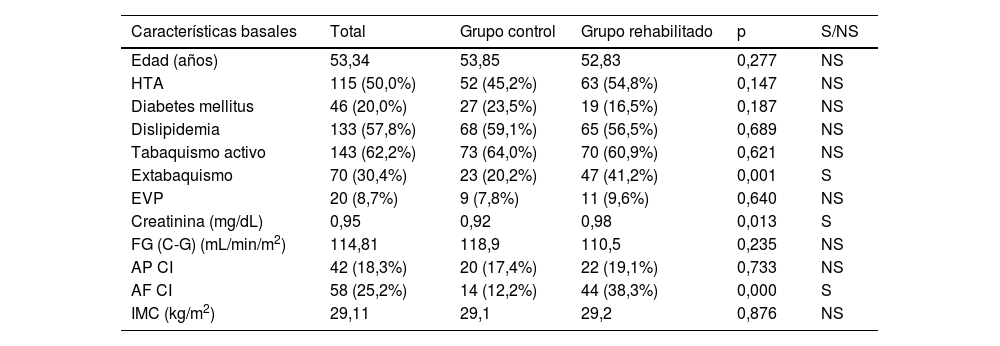Reducción de eventos cardiovasculares mayores (MACE) a 5 años en pacientes que sufrieron un síndrome coronario agudo (SCA) revascularizado percutáneamente y completaron un programa de rehabilitación cardiaca.
MétodosSe incluyeron 230 varones consecutivos con diagnóstico de SCA y revascularización percutánea en el primer semestre de 2015 que cumplieran los criterios de inclusión establecidos. Se constituyeron 2 cohortes de 115 pacientes, uno de ellos (GR) que completó el programa de rehabilitación cardiaca y otro (GC) que recibió atención ambulatoria convencional. Se analizaron las características basales de ambos grupos y se analizaron los MACE a 5 años de seguimiento. Se consideraron eventos el reingreso por nuevo SCA, insuficiencia cardiaca, accidente cerebrovascular o el fallecimiento del paciente.
ResultadosA 5 años de seguimiento hubo una reducción estadísticamente significativa en la tasa de MACE (27,19% vs. 7,83%; OR 0,23 [IC 0,10-0,50]; p=0,0001), mortalidad por todas las causas (OR 0,12 [IC 0,01-0,94]; p=0,01), tasa de reinfarto (OR 0,29 [IC 0,11-0,77]; p=0,007) y accidente cerebrovascular (p=0,014) a favor del GR. La supervivencia libre de MACE fue estadísticamente menor en el GR independientemente del riesgo (HR 0,25 [IC 0,12-0,53]; p=0,000).
ConclusionesEn nuestra muestra, los programas de rehabilitación cardiaca mostraron un beneficio pronóstico en pacientes con diagnóstico de SCA revascularizados percutáneamente, con una reducción significativa de MACE, tasa de reinfarto y accidente cerebrovascular a 5 años de seguimiento.
Reduction of major adverse cardiovascular events (MACE) at 5 years in patients with acute coronary syndrome (ACS) and percutaneous coronary intervention who completed a cardiac rehabilitation program.
MethodsWe included 230 consecutive men with a diagnosis of ACS and percutaneous coronary intervention in the first half of 2015 according to the inclusion criteria. Two cohorts of 115 patients each were compared, one of them (rehabilitated group) with patients who completed the cardiac rehabilitation program and the other (control group) who received conventional outpatient care. Base-line characteristics and MACE at 5-years follow-up were compared and analyzed. MACE included re-infarction, heart failure, cerebrovascular accident and all-cause mortality.
ResultsAt 5 years of follow-up, a statistically significant reduction in MACE (27.19% vs 7.83%; OR 0.23 [IC 0.10-0.50]; P=.0001), all-cause mortality (OR 0.12 [IC 0.01-0.94]; P=0.01), re-infarction rate (OR 0.29 [IC 0.11-0.77]; P=.007) and cerebrovascular accident (P=.014) was found in the rehabilitated group (RG). MACE-free survival was significantly longer in the RG, regardless of risk (HR 0.25 [IC 0.12-0.53]; P=.000).
ConclusionIn our sample, cardiac rehabilitation programs showed a prognostic benefit in patients with ACS and percutaneous coronary intervention, with a statistically significant reduction in MACE, re-infarction rate and CVA at five-year follow-up.














